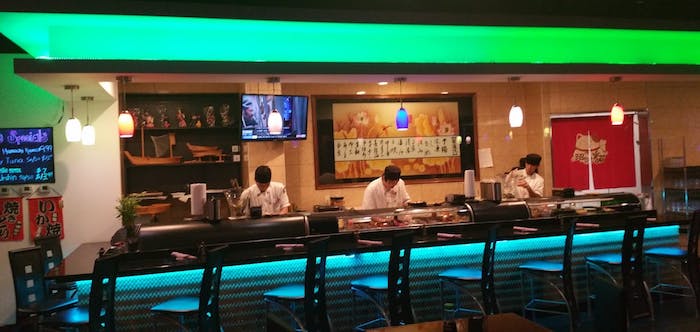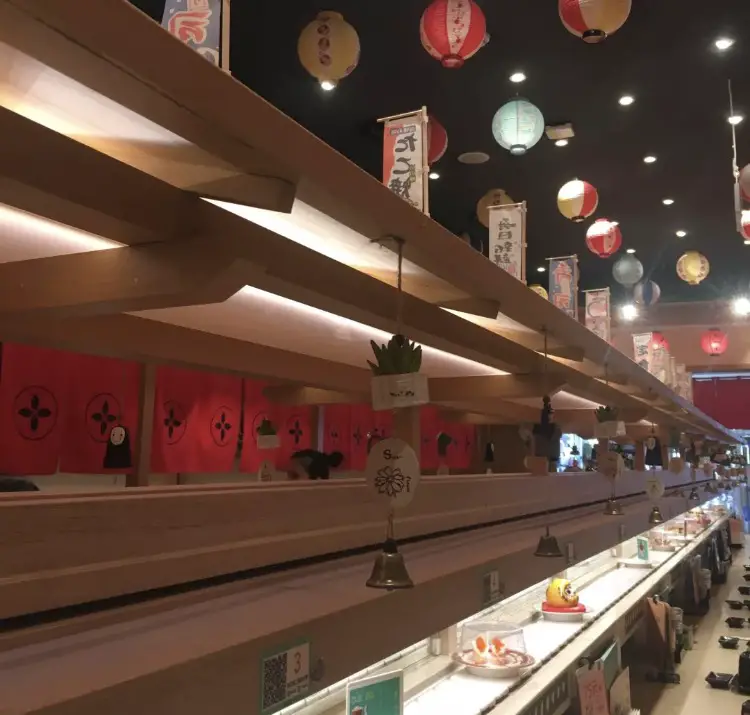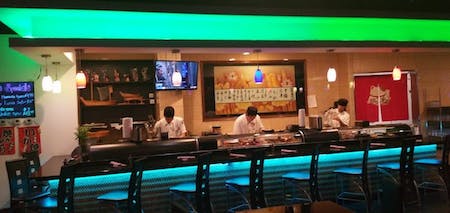We are reader supported. When you purchase through links on our site, we may earn an affiliate commission. Also, as an Amazon affiliate, we earn from qualifying purchases.

In North America, sushi bars are trending! With the growing popularity of sushi in the West, it is no wonder people all over the United States and Canada are heading to these establishments in search of the perfect sushi experience. Which begs the question, “What exactly is a sushi bar anyway”?
What is a sushi bar? A sushi bar is different than a regular restaurant. At a sushi bar, you sit at a counter and get your food directly from a chef, instead of a server. There, you can speak directly to the chefs and watch them as they prepare your meal. Or, you can choose from a variety of ready sushi options.
In this article, we will discuss what you should know about sushi bars as well as sushi bar etiquette. So, if you are ready to begin, then let’s get started…
What is a Revolving Sushi Bar?

A revolving sushi bar is also known as ‘conveyor belt sushi.’ The Japanese call is ‘kaiten-zushi’ which literally means ‘rotation sushi.’ It is very popular in the East, especially in Japan, as well as other countries such as Australia and New Zealand.
Conveyor belt sushi bars were invented by Yoshiaki Shiraishi in an attempt to better serve the public. He had trouble staffing his restaurant and found it difficult to manage on his own. He got the idea after seeing beer bottles on a conveyor belt in an Asahi brewery. It took five years to design and develop. In 1958, the first revolving sushi bar, Mawaru Genroku, was open for business.

A revolving sushi bar is a restaurant in which the plates containing the sushi are placed on a rotating conveyor belt that moves through the restaurant, past every table, counter or seat present. At these bars, customers can make special order requests and the final bill is calculated based upon the number and types of sushi consumed. Here, selection is not limited to just sushi. Drinks, soups, desserts, etc. are also available.
Condiments (including wasabi, soy sauce, and pickled ginger) and tools (such as chopsticks and wet paper towels) are found near the seats. Tea and water are usually complimentary. The cups are often stacked on shelves just above the conveyor belt for self-serve purposes. The teabags or green tea powder is usually placed in a container on top of the tables. For take-out customers, sushi boxes are also available.
How do you eat at a Sushi Bar?
How you eat at a sushi bar is often referred to as sushi bar etiquette. Many people are nervous the first time they visit a sushi bar, worried they won’t have a clue what to do or say and thus end up embarrassing themselves. However, this couldn’t be farther from the truth! Sushi bar chefs are used to new customers and are very friendly and accommodating.
To make it easier, go with a friend who has been to a sushi bar before. This will provide you with a sense of security and comfort and make the experience more enjoyable overall. Now, let’s explore in more detail how to eat at a sushi bar. Consider the following ten steps:
- Find the ‘Itamae’. Get the ‘best seat in the house’ at a sushi bar! Finding the seat near the head chef, if there is more than one chef at the counter, is key. Usually, he (or she) will be situated in the most prominent place behind the refrigerated counter, somewhere near the door. He (or she) will also be the one supervising the other chefs.
- Get your chopsticks ready. Once seated at the sushi bar, get prepared for what is to come. Open the package of chopsticks and fold the packaging to be used as a chopstick holder. Break the chopsticks apart and place them together with the eating end facing left on top of the holder. Rubbing the two eating ends together to remove any splinters that may occur when disposable chopsticks are broken apart is often considered a ‘no-no’ at sushi bars.
- Get your soy sauce ready. Pour a small amount of soy sauce into the saucer provided. There is a debate as to whether or not it is proper sushi etiquette to add wasabi directly to the soy sauce. The ‘experts’ will often say no, however, it really depends upon your own personal preference.
- Clean your hands. Use the ‘oshibori’, which is the little towel provided to you, to clean your hands before receiving your sushi meal. It may be hot or cold, depending on the season. Once used, fold the towel up and place it back into the dish it came with. Continue to use it whenever necessary throughout your meal.
- Choose your drink. Upon being seated, you will be asked by the server what you want to drink. Or, you may be given green tea or ‘ocha’ right away. Many sushi bars are licensed and offer beer or ‘sake’ (Japanese rice wine) in addition to non-alcoholic beverages.
- Choose your food. At the sushi bar, you will be given a menu by which to order from or you will be asked to choose an item from the refrigerated case in front of you. To have sushi ‘specially made’ (with ingredients omitted or substituted) will likely cost more than ordering off the menu or choosing from the refrigerated options available.
- Eat you sushi properly. With your chopsticks in hand, pick up a piece of sushi, dip it into the soy sauce and eat immediately. Then, eat a piece of pickled ginger to cleanse your pallet and follow with a sip of green tea. Continue eating in this manner until the sushi is fully consumed. When finished, lay your chopsticks on the chopstick holder (never directly on top of the table) and point to the left. Chopsticks pointed to the right is considered bad luck!
- Thank (and tip) the chef. Say ‘domo arigato’ (which means ‘thank you’) to the chef and provide him (or her) with a 10-20% tip of the bill’s total amount, if you are generally pleased with the food and service provided.
- Pay your bill. Upon receiving you bill, pay (and tip) the server and thank him (or her) by saying ‘domo arigato’ once again. Usually, the wait staff is given a 15-20% tip as well, if you are happy with service.
What not to do at a Sushi Bar
There are some ’do’s’ and ‘don’ts’ for eating at a sushi bar. We covered most of the ‘do’s’ above. Now, let’s go over some of the ‘don’ts’, which include the following:
- Do not add wasabi directly to the soy sauce. This point is up for debate but in most cases, true sushi lovers often say not to do this. The chef has already put the ‘correct’ amount of wasabi inside the sushi roll and it could be seen as ‘rude’ to add extra wasabi to the soy sauce.
- Do not ask the chef where or how he (she) was trained. In the case where the chef may not be Japanese, it is rude to assume that because of this, he (or she) is not properly trained.
- Do not ask ‘what is fresh today’? It is not polite to ask what is fresh or in season at a sushi bar. The ingredients used will always be of top-quality and to assume otherwise is not acceptable.
- Do not overuse the soy sauce. Dousing your sushi in soy sauce is a no-no. Not only will it overpower the flavor but it will also make it difficult to eat.
- Do not be wary. Dining at a sushi bar may be a new or unique experience, but that does not mean you should feel nervous. Ask questions, the chefs will be more than happy to help you. Do not hesitate to try new foods. After all, that is part of the fun!
Is it OK to Eat Sushi with Your Fingers (or a Fork)?
The answer to the above question is yes, to both! It is perfectly acceptable to eat sushi with your fingers or a fork at a Japanese bar, if chopsticks are not for you. After all, sushi began as a finger food. The only time in which fingers are not recommended is in the case of sashimi, which should be eaten with chopsticks (or a fork). For more information – Do you eat sushi with hands or chopsticks?
Conclusion
In conclusion, a sushi bar is a place where you go to eat sushi at a bar or counter. There, you can speak directly to the chefs and watch them as they work. Sushi bars are a truly unique and fun experience. With a little understanding of proper sushi etiquette, it is a wonderful place to indulge in fresh, authentic sushi. So why not visit your local sushi bar today? Bon apetit (or ‘Itadakimasu’ as they say in Japan)!

